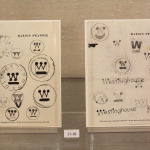A new exhibition at Sterling Memorial Library aims to celebrate the life of an iconic graphic designer.
Located in the library’s Memorabilia Room, “Paul Rand: Pioneer by Design” opened on Sunday and features a variety of the designer’s works, including magazine advertisements, illustrations for children’s books and writings on design theory. The exhibition is curated by Molly Dotson, special collections librarian; Jae Rossman, assistant director for special collections and Holly Hatheway, assistant director for collections, research and access services. Dotson highlighted Rand’s longstanding relationship with the University and said that the exhibit was conceived as a commemoration of the designer’s centennial — he would have turned 100 years old this August.
“We wanted to showcase the wealth of materials available in archival collections, as well as focus on his writings and his teaching here at Yale,” Dotson said. “The goal is to showcase the Paul Rand papers as a resource for students, classes and researchers.”
Organized in roughly chronological order, the objects in the exhibition follow various stages of Rand’s career. During his early years, Dotson said, the designer engaged heavily in editorial design and advertising. Examples from this period of his career include a handful of cover designs for “Direction” — an anti-fascist cultural magazine — completed in the late 1930s and early 1940s.
Dotson noted that Rand’s commercial design vocabulary drew heavily upon concepts adapted from European avant-garde influences.
“For him, design was about problem-solving,” Dotson said. “He took various design principles from modern art trends, but always brought it back to the particular problems of a specific project or client.”
On the advertising end of the spectrum are a series of designs for an air freshening product called “Airwick,” Frazer Manhattan luxury cars, Coronet Brandy and El Producto cigars, whose advertisements and packaging feature swaths of palm green and flamingo-pink, as well as Panama hats and playing cards.
Amounting to much more than tongue-in-cheek visuals and witty wordplay, Rand’s formal advertising vocabulary was revolutionary, Dotson said. She explained that in Rand’s designs, text and images were directly integrated into a cohesive whole for the first time in the history of graphic design. Previously, she noted, the pictorial and verbal elements of advertisements appeared as physically separate entities.
The exhibition also features examples of the designer’s “corporate identity” work, including a variety of logos for a number of corporations — IBM’s, with its horizontally-striped block capitals, is still in use today. Samples of Rand’s own writings on design theory and lesser-known selections, such as the four-part series of children’s books that he and his wife jointly produced, appear in the exhibit as well.
Dotson said the concluding section of the exhibition focuses on Rand’s career at Yale, where he joined the faculty in 1956 — five years after the University established the nation’s first graduate program in graphic design. Rossman said this portion of the exhibit touches upon the designer’s relationship with the School of Art. Along with a collection of prints he designed for the school, there are projects Rand assigned his graduate students, including the redesign of a Parcheesi game board.
Mark Saba, who designed the exhibit’s banner and online promotional materials as well as the show’s section labels, said that as a graphic designer, he is glad that the University is showcasing Rand’s work and revisiting the importance of his career.
“I think the thing that separates Paul Rand from other designers is his willingness to use design as a functional tool, but that gives something commercial a meaning and an identity,” added prospective architecture major Natalie Sheng ’17, who visited the exhibit.
Paul Rand: Pioneer by Design will be on view through Jan. 30.










